|
 Hygrocybe rubrocarnosa Hygrocybe rubrocarnosa
SynonymsHygrophorus rubrocarnosus
Hygrocybe rubrocarnosa
BiostatusPresent in region - Indigenous. Endemic
Images (click to enlarge)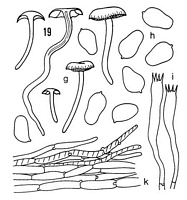
Caption: Hygrocybe rubrocarnosa (Stev.) (type; Herb. HK. ZT 68/644): g. carpophores. - h. spores. - i. basidia. - k. cuticle | 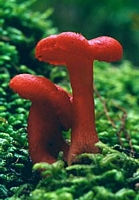
Caption: Hygrocybe rubro-carnosa
Owner: Kaimai Bush | 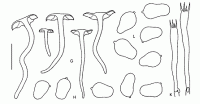
Caption: Fig. 8 Hygrocybe rubrocarnosa (Stev.) Horak. (G-K: ZT 68/644):
G. basidiomes. H. spores. K. basidia. L. spores
(K 568, type). | 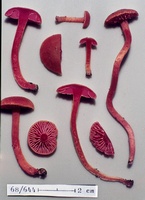
Caption: ZT68-644
Owner: E. Horak: © Creative Commons Attribution-Noncommercial 3.0 New Zealand | 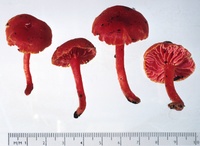
Caption: ZT71-088
Owner: E. Horak: © Creative Commons Attribution-Noncommercial 3.0 New Zealand | 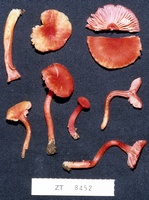
Caption: ZT8452
Owner: E. Horak: © Creative Commons Attribution-Noncommercial 3.0 New Zealand | 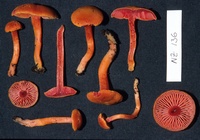
Caption: ZT9402, NZ-136
Owner: E. Horak: © Creative Commons Attribution-Noncommercial 3.0 New Zealand | 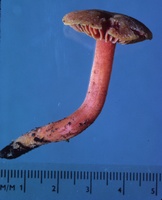
Caption: ZT0739
Owner: E. Horak: © Creative Commons Attribution-Noncommercial 3.0 New Zealand |  | 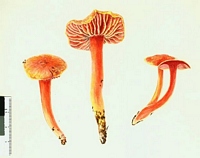
Caption: Watercolour
Owner: G.M. Taylor | 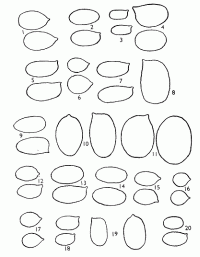
Caption: Spores X 2000 1. Hygrophorus salmonipes 2; H. elsae; 3, H .julietae; 4, H. variabilis; 5, H. lilaceo-lamelllatus; 6, H. muritaiensis; 7, H. keithgeorgei; 8, H. pseudococcineus; 9, H. rubro-carnosus; 10, H. miniceps; 11, H. procerus; 12, H. multic |
Article: Horak, E. (1990). Monograph of the New Zealand Hygrophoraceae (Agaricales). New Zealand Journal of Botany 28(3): 255-306 (http://www.rsnz.org/publish/abstracts.php).
Description: Pileus -35 mm, hemispherical becoming planoconvex to irregularly expanded with
flat to subdepressed centre; brilliant red (crimson, scarlet) fading to orange-yellow;
dry, glabrous or velvety to minutely fibrillose-subsquamulose in aged basidiomes,
margin substriate.- Lamellae 10-15 (1 -3) rather distant, broadly adnate to
decurrent, occasionally subemarginate, up to 6 mm wide; concolorous with pileus
at first, fading to pale red or nearly white, edges concolorous, entire. - Stipe
25-70 x 2-5 (-6) mm, cylindrical, equal, occasionally attenuated towards base;
coloured like pileus, paler towards base; dry, glabrous or silky-fibrillose,
hollow, brittle, single or caespitose. - Context beetroot red, changing to orange
in cortex of pileus and stipe (on drying specimens). - Odour and taste not distinctive.
- Chemical reactions on pileus: KOH - negative.
Spores 7-9 (-10) x 4-6 um, distinctly pear-shaped, obtusely constricted. -
Basidia 45-65 x 68 um, 4- (rarely 2-) spored. - Cystidia absent. - Pileipellis
a cutis or trichoderm of cylindrical repent to suberect hyphae (5-14 um diam.),
membrane not gelatinised, with reddish-yellowish (KOH) plasmatic pigment; clamp
connections present (Pl. 1, Fig. 1).
Habitat: ECOLOGY: Common; saprobic on soil among litter under Nothofagus (N. fusca,
N. menziesii) and in broadleaved-conifer forest (dominated by Dacrydium
cupressinum) with tree ferns. March-September.
Distribution: DISTRIBUTION: NZ (NA, SA, W, N).
Notes: This striking species with constricted spores is close to H. imazekii
Hongo (1955) described from Japan.
Article: Horak, E. (1971). A contribution towards the revision of the Agaricales (Fungi) from New Zealand. New Zealand Journal of Botany 9(3): 403-462 (http://www.rsnz.org/publish/abstracts.php).
Notes: Hygrophorus rubrocarnosus Stevenson (28 D) = Hygrocybe rubrocarnosa
(Stevenson) comb. nov. (Basionym: H. rubrocarnosus Stevenson, Kew Bull. 16:
379, 1962)
Article: Stevenson, G. (1963) [1962]. The Agaricales of New Zealand: IV. Kew Bulletin 16(3): 373–384.
Description: Pileus 3-5 cm. diam., orange yellow, planoconvex, matt to fibrillose; flesh
bright red, firm, rather thick. Gills adnate, red with white mealiness, cream
on edges, distant, rather thick. Stipe 7 cm X 6 mm., bright orange yellow above,
paler towards base, silky striate, twisted and splitting, hollow to stuffed,
tough; flesh of stipe also bright red. Spores 10-10.5 X 5-6 µm., ovoid, hyaline,
thin-walled. Basidia 45-60 X 5 µm., four-spored.
Habitat: habitat: under forest, Levin, 22.5.19491 Stevenson.
Notes: Another species with red flesh has been described, H. hyphoaemactus Corner in
Trans. Brit. Myc. Soc. 20: 180 (1936). It is however, glutinous, and has dimorphous
basidiospores.
Article: Horak, E. (1973). Fungi Agaricini Novazelandiae I-V. Beihefte zur Nova Hedwigia 43: 200 p.
Description: Pileus 10-35 mm diam., hemispherical becoming plano-convex to irregularly expanded, scarlet to deep red fading to orange-yellow, glabrous or (in aged carpophores) minutely fibrillose-squamulose, dry, occasionally margin of pileus striated. Lamellae broadly adnate to decurrent, blood red when young turning pale red or cream, rather thick, distant, gill edge concolorous. Stipe 25-70 x 2-5(6) mm, cylindric, equal, sometimes attenuated below, concolorous with pileus paler towards the base, longitudinally fibrillose, silky, dry, hollow, single or in clusters. Context deep red especially in the cortex of pileus and stipe. Taste and odor not distinctive. Chemical reactions on pileus: KOH - negative.
Spores 7.5-10 x 4-6 µm, pyriform to ovoid, sometimes distinctly constricted, smooth, inamyloid. Basidia 45-65 x 6-8 µm, 4- and 2-spored. Cystidia absent. Cuticle a cutis consisting of suberect ends of the hyphae (5-10 µm diam.) forming the small squamules, membrane not gelatinized, conspicuous yellowish-red pigment dissolved in the cell sap present. Clamp connections numerous.
Habitat: In soil under Dacrydium, Podocarpus, Nothofagus; Cyathea, etc. New Zealand.
Notes: Stevenson (1962: Pl. 6/8, not 6/6 which refers to Gl: bichromus Hk.!) gives an excellent picture of this characteristic species. The painting shows well the deep red layer beneath the cuticle and the upper portion of the stipe.
|